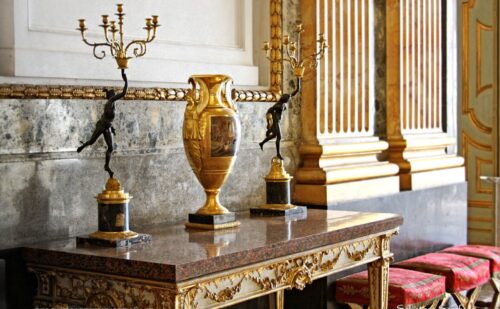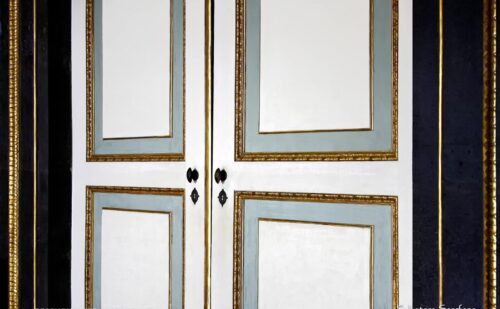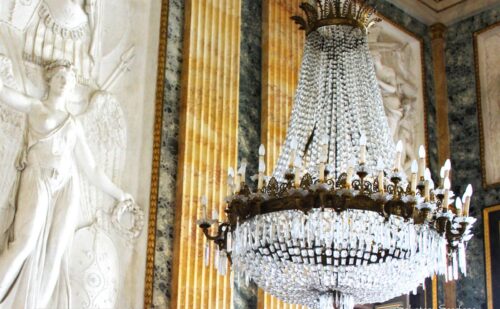The Hall of Mars, the Antechamber of the Barons and Officers
The Hall of Mars was the Antechamber for the Titled and Barons of the Kingdom, Senior Officers and Foreign intendants
Description
The Antechamber of the Barons, also known as the Hall of Mars, was intended for the use of “Antechamber for the titled, the nobles, major officers and foreign intendants”. Mars was the god of war of ancient Rome.
This and the Antechamber of the Ambassadors (called Hall of Astrea) were no longer designed by Carlo, the son of Luigi Vanvitelli, but by Antonio De Simone, architect of the Murat court, built at the same time and completed in 1815. At the time, in fact, the Kingdom was no longer under the Bourbon domination but of Joachim Murat and Carolina Bonaparte. Upon their return, the Bourbons made no changes to this room.
The iconography of the Hall represents military values as indispensable tools for giving glory and fame to power.
Decorations of the Hall of Mars
The fresco and the ceiling
Author: Giulio Brevetti
On the vault, among white and gilded stucco trophies, palm trees and oak crowns (works by Carlo Beccalli and Lucio Lucchesi), the painting of “The Triumph of Mars” by Antonio Raffaele Calliani stands out in the centre.
In the Antechamber of the Barons, in accordance with the plastic decoration dedicated to episodes from the Iliad, the young Calliano chooses to represent a precise passage from the V canto, the one in which we witness – following the wounding of Aeneas and the providential appearance of his mother Venus – the clash between Diomedes and Ajax on one side, and “Priamide Hector with a great agitator helmet” on the other, on whose chariot appears the god of war, protector of the Trojan line-up.
The iconography of the Murat royal couple
Autore: Giulio Brevetti
Within the large iconography of Gioacchino and Carolina Murat, an important place would go to the two paintings that adorn the vaults of the Hall of Mars and the Hall of Astrea in the Royal Palace of Caserta, the extreme point of their artistic parable: it is not explicitly celebratory scenes, nor of portraits tout court, but of historical-mythological episodes which for this very reason escaped the Bourbon iconoclasm, limited only to altering the faces of the two Napoleonic figures depicted at the epilogue of their rapid rise, as recalled by the archival documents.
Even if today they don’t seem to bear traces of their patrons, the Triumph of Mars and the Triumph of Justice, created simultaneously between 1812 and 1815, constitute two complex and unpublished portraits of the French royal couple: choosing to appear in the guise of a god and than an allegorical figure, the Murat spouses almost seem to adapt to those environments where their predecessors allowed themselves to be immortalized in other guises, thus betraying a desire to conform to the figurative imagery of that Ancien Régime which they had only in theory supplanted. […]
In the many paintings that illustrate the Napoleonic battles, Murat was always depicted a step behind, in the background compared to the hero of that deed, and the various celebratory painters must have struggled so that the overbearing physicality of the first did not obscure the minute presence of the second.
Now, having become ruler of Naples, the scene is all to himself: in Calliano’s painting, he dominates not a simple battlefield, but the one par excellence; now, it is up to him to obscure what should have been the protagonist, that Ettore from whom he steals the show, almost completely hiding it with his irrepressible physicality. The Triumph of Mars is therefore the exaltation of adventure, of the warlike spirit, of military art, of contemptuous courage of danger and death. Those peculiar aspects, that is, which characterized Murat’s personality in life.
WALLS AND FLOOR
The walls of the Antechamber of the Barons are made of marble and scagliola and decorated with twelve relief stucco panels. The high relief panels:
- the large ones on the smaller walls depict two “Winged Victories with trophies”
- the largest on the long wall depicts “Prudence and Strength flanked by a war trophy surmounted by Fame and Glory”
- The nine minor high reliefs depict episodes of Mars, god of war, taken from the Iliad.
All the high reliefs on the walls, made in stucco since 1812, are the work of Valerio Villareale, the main pupil of Antonio Canova.
Valerio Villareale was certainly the best of the sculptors who worked in Caserta. Born in Palermo in 1773, he studied in Sicily with the painter Giuseppe Velasco (among the main exponents of neoclassicism) and in Rome under the guidance of Antonio Canova, from whom he learned safe and robust modeling and the classic composure of composition. At the beginning of 1812 Villareale was working on three panels for the overdoors of the Hall of Mars; later he executed two more, together with the large bas-relief in the center of the wall opposite the windows and the Victories with trophies on the smaller walls. Together with Villareale, the sculptor D’Antonio, Claudio Monti and the aforementioned Domenico Masucci took part in the execution of the bas-reliefs.
The inlaid floor in verde antico, alabaster and Viterlian marble completes the decoration of the Antechamber of the Barons. It is made up of a hexagonal pattern, with a Greek fret frame and a hexagonal rosette in the centre. Design by the architect della Sala, Antonio de Simone, and execution by Carlo Giobbè.
Furnishings
The Empire-style chandeliers are in Bohemian crystal, while the large alabaster cup (170cm high) was a gift from Pope Pius IX to King Ferdinand II on the occasion of his stay in Caserta in 1849. There are stools in the room Empire from the Murat era, objects in the same style, and consoles from the previous era, in the Neoclassical style, designed by Carlo Vanvitelli and made in the typical Bourbon white and gold.
A curiosity: to create chiaroscuro, the gilding was partly polished and partly left opaque.
Link esterno












